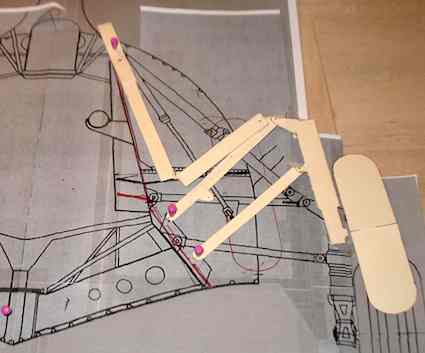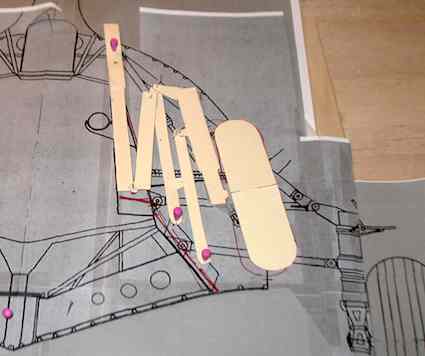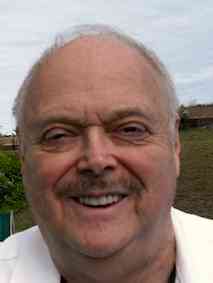 |
Flying High With Electric Power!
The Ampeer ON-LINE!
Fly the Future - Fly Electric! |
Site Table of Contents
| President: | Vice-President: | Secretary/Treasurer: |
| Ken Myers | Richard Utkan | Rick Sawicki |
| 1911 Bradshaw Ct. | 240 Cabinet | 5089 Ledgewood Ct. W. |
| Commerce Twp., MI 48390 | Milford, MI 48381 | Commerce Twp., MI 48382 |
| (248) 669-8124 | (248) 685-1705 | 248.685.7056 |
 | ||
| Board of Directors: | Board of Directors: | Ampeer Editor |
| David Stacer | Arthur Deane | Ken Myers |
| 16575 Brookland Blvd. | 21690 Bedford Dr. | 1911 Bradshaw Ct. |
| Northville, MI 48167 | Northville, MI 48167 | Commerce Twp., MI 48390 |
| 248.924.2324 | 248.348.2058 | 248.669.8124 |
| Mailed Ampeer printed subscriptions are no longer available.
The Ampeer is FREE on-line in Acrobat .pdf format and HTML with active links! | ||
| The Next Meeting:
Date: Thursday, April 11Time: 7:30 p.m. Place: Ken Myers' house, Commerce Twp., MI 48390 | ||
| What's In This Issue? | ||||
| Saving Our Hobby, from the DAM newsletter, comments on the biggest threat to our hobby today. | PBY 5-A in the Planning Stages Scott Copeland shares some information on the design for his new plane. | |||
| Selecting a Li-Poly Battery for a Given Motor, Ken Myers answers a question from Phil Alvirez regarding battery selection for a given power system. | Upcoming Keith Shaw Birthday Party Electric Fly-in 2013 info and map | |||
| The March EFO Meeting, Joe Hass; Hangar 9 Meridian 10cc ARF, Hobby Lobby F-35 Lightning II 360 Degree Thrust Vectoring Jet, Great Planes ElectriFly Citabria, and Flyzone Fokker Dr.1 WWI Micro EP, Tom Bacsanyi - Hangar 9 P-51D Blue Nose 60 ARF, Bill Brown - Wright Model B, Richard Utkan - Hobby People Wild Wing and Denny Sumner Gee Bee model Y | Upcoming Lake Orion E-Fly-In Pete Foss provides information on the upcoming Skymasters E-fly-in in June. | |||
| EFO Member Howard Shorr Passes, a note of Howard's passing. | Announcing the 29th Annual Mid-America Electric Flies, links to the Flyer and map and hotel info for the 2013 Mid-Am. | |||
The following is reprinted from the Detroit Aero Modelers March newsletter. "There has recently been an increase in concern about videos and still photos taken from drones. The problem centers on invasion of privacy. With the proliferation of RTF quadcopters outfitted with cameras, it has become simple for anyone to plunk down some money, and go 'window-shopping' in the neighborhood, without any flight training. If we don't want laws that paint with a wide brush outlawing R/C flight, we should be very outgoing in describing what it is that we do, and emphasize that we are doing it only in public airspace! Now is NOT the time to be posting videos shot from you model as it cruises down the back streets of your neighborhood, and over the neighbor's pool!" Let's all do it right and share that we are doing it 'right' with everyone we come into contact with. KM From Scott Copeland via email Hello Ken, I thought you might be interested to hear about a long term project that I've started planning over the last few weeks. I have had a goal for many years to get into competitive scale modeling and I'm finally getting to that point. I'm currently building a Dave Platt Zero (powered by IC) but the next project is a big PBY. The wingspan will be 12 ft. and it will hopefully have the full treatment of details to make it a competitive scale model. It will be powered by 2 Astro 40's with Superboxes (I will use one of the ESC's you sent me - Thanks!) with an estimated weight of 20-30 lb. I plan to build my own retractable landing gear and retractable tip floats. I'm still in the design process but have worked out the landing gear geometry and plan to build that first. This project will be a series of baby steps. We had previously conversed regarding one of your Ampeer contributors who had questions about power for his PBY and it sounded like it was a lead sled. I hope that this one will fly prototypically. If I keep the weight within the limits of my calculations, it should have a reasonable thrust to weight ratio to fly in a scale manner. I should be able to swing a scale 3-blade prop! Here are a few pictures of the landing gear mock-up. 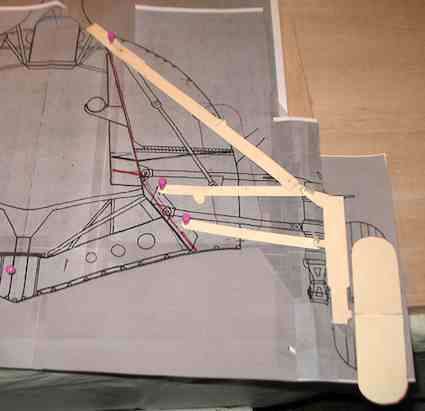
Take care,
Selecting a Li-Poly Battery for a Given Motor
Hello Ken, How do you decide what battery is the right one for a certain motor? Thanks,
Unfortunately, the battery 'size' is only slightly related to a given motor. Jim Young needed to replace his Astro Flight 40G brushed motor in his Skybolt biplane. He decided to use this motor with a 6S LiPo. The motor is an energy converter and can be used in a lot of different applications. The mission of the aircraft, as well as the aircraft's physical size for prop clearance, determines what battery to use. Also, your personal acceptable flight time comes into play. I like to use Cobra motors, from Innov8tive Designs, for examples because Lucien Miller has taken a lot of time to create prop charts for them. For this example, we'll look at the Cobra C-2213 series, since you like smaller aircraft. It is an approximately 60g motor and comes in four different Kvs. "The motors are the: Cobra C-2213/26 Brushless Motor, Kv=950
Cobra C-2213/22 Brushless Motor, Kv=1100
Cobra C-2213/18 Brushless Motor, Kv=1350
Cobra C-2213/12 Brushless Motor, Kv=2000
These are all physically the same motor, but with different winds on the stator arms. The Cobra C-2213/26 has more winds, of thinner wire, compared to the other three. The smaller gauge wire limits the current handling ability of the wire in the winds and results in the highest resistance. Conversely, the Cobra C-2213/12 has fewer winds, of thicker wire, compared to the other three. The larger gauge wire allows for a larger current through the winds and results in the lowest resistance of the four examples. In very simplistic terms, the /26 can swing a larger diameter prop more slowly than the /12, and motor selection of any of them would be mission and prop based. While a 3S Li-Po was noted in the specifications, a 2S Li-Po or 4S Li-Po might be chosen depending on the mission and selected prop for the mission, all the time keeping the amp draw within a 'safe' range. At 7.4v the Cobra C-2213/26 can swing an APC 13x4E at 4950 RPM while drawing 8.8 amps for 65.12 watts in. Typically I use a constant static 10C discharge rate to determine the battery mAh for the flight time I desire, but with this large diameter prop and a pitch speed of only 18.75 mph [(4950 RPM * 4 in. pitch)/1056], the prop and pitch speed appear appropriate for some type of indoor/outdoor light breeze 3D-type plane. To keep the weight down and power up on a 3D burst flier, I recommend a constant static 15C discharge rate to determine the battery mAh. 8.8 amps divided by a constant static 15C discharge rate = 0.587Ah or 587mAh, and in this case, it is a 2S Li-Po. For a 'safety margin' a 20C or higher manufacturer/supplier rating would be appropriate. This same motor could be used with a 4S Li-Po for a much faster plane, which changes the mission and prop. Using an APC 7x6E at 14.8v yields 11,100 RPM with an amp draw of 8.62 amps and a pitch speed of 63 mph. While the amp draw is similar to the APC 13x4E on a 2S Li-Po, the watts in are now 127.6. A constant static 15C discharge rate might again be appropriate to determine the mAh, as this would be a "little zoomer". his time the battery would be a 4S 575mAh manufacturer/supplier 20C or greater to allow for a safety margin. For a "typical" park flyer a 3S Li-Po and an APC 10x6E prop could be used. A 10x6E at 11.1v yields 7,260 RPM with an amp draw of 12.02 amps and a pitch speed of 41.25 mph. This is where I would use a constant static 10C discharge rate to determine the battery mAh for a flight time that I would find acceptable. 12 amps divided by a constant static 10C discharge rate = 1.2Ah or 1200mAh. The appropriate pack would be a 3S 1200mAh manufacturer/supplier 15C or higher Li-Po. Again this allows for a safety margin. Hopefully you can see it is not the motor but the amp draw and mission, as well as your personal preference for flight time, that determine the battery 'size'. Battery weight can be estimated using this formula.
The estimated weight for a 2S 587mAh 20C pack would be 587 / 35 * 2 = 33.5g A Hyperion G3 CX - 2S 550mah 25C Lipo comes close to meeting the requirement and weighs 32.5 oz. The estimated weight for a 4S 575mAh 20C pack would be 575 / 35 * 4 = 65.7g I only found up to a 3S 550mAh 25 C. To create a 4S, two of the Hyperion 2S 550mAh 25C could wired in series and the weight would be about 65g. The estimated weight for a 3S 1200mAh 15C pack would be 1200 / 35 * 3 = 102.9g A Zippy-K Flightmax 3S 1200mah 25C Li-Po weighs 103g. Even though a 15C manufacturer/supplier rating would have been okay, I used the 25C pack weight as I found that one quickly online. As you can see from the examples, the formula for pack weight in grams does give a reasonable indication of the battery pack weight. To answer your original question; is there a way to determine a battery size for a given motor, well not exactly. Once you determine the mission and amp draw, you certainly can figure the battery size based on the formulas I've given. One very important thing to keep in mind is that the constant static C rate used to determine the mAh is NOT the C rating of the battery pack by the manufacturer/supplier. For a safety margin, the C rating of the battery pack by the manufacturer/supplier should be higher than the constant static discharge C rate used to determine the battery’s weight. If the specific amp draw informtion is not available for a given motor, battery, prop combination, there is a 'quick and dirty' method to calculate an acceptable battery mAh. The number of Li-Po cells is the number recommended by the manufacturer/supplier of the motor. The formula is:
From the previous example:
A pack with a 20C or higher rating would cover all of the acceptable amp draws noted for the Cobra C-2213 series. A 1.55Ah battery at a 20C discharge rate is 31 amps. Again, the estimated battery weight formula is:
A Hobby King Rhino 3S 1550mAh 30C weighs 136g. Heavier:
Cobra C-4130-12 540Kv
397g ^ 0.6666667 / 10 = 5.4Ah or 5400mAh 5400mAh was round to 5500mAh because there are more brands with this capacity. A pack with a 20C or higher rating would cover all of the acceptable amp draws noted for the Cobra C-4130 series. A 5.5Ah battery at a 20C discharge rating is 110 amps.
Lighter:
Cobra C-2204/32 1960Kv
22.5g ^ 0.6666667 / 10 = 0.797Ah or 797mAh 797mAh was rounded to 800mAh, as that is a common pack size. A pack with a 20C or higher rating would cover all of the acceptable amp draws noted for the Cobra C-2204 series. A 0.8Ah battery at a 20C discharge rating is 16 amps.
Upcoming Keith Shaw Birthday Party Electric Fly-in 2013 The Balsa Butchers will once again be hosting the "Keith Shaw Birthday Party Electric Fly-In" at their field near Coldwater, MI. The event will take place on June 8 and 9, 2013. Contest Director: Dave Grife - E-mail: grifesd@yahoo.com or Phone: 517.279.8445
The Flying Field will be open Friday, June 7 for early arrivals Saturday, June 8, hours are from 9 a.m. 'til 5 p.m.
Landing Fee is $10 for the weekend. Directions: Quincy is approximately 4.5 miles east of I-69. Clizbe Road is approximately 1.6 miles east of Quincy. The Flying site is approximately 1.5 miles south of US-12 on the west side of Clizbe Road. |
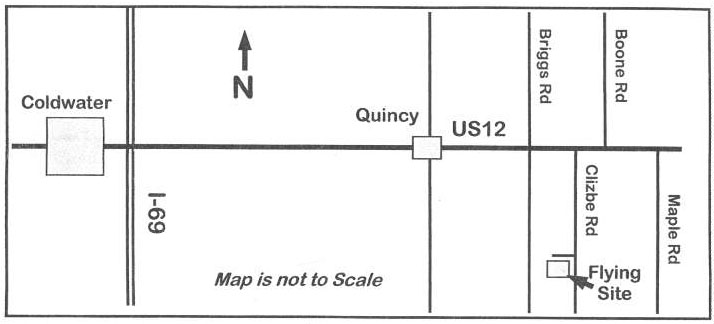
The meeting was held on the evening of March 14 at Ken's house. It was a meeting filled with new planes! Joe Hass, brought along four new planes. 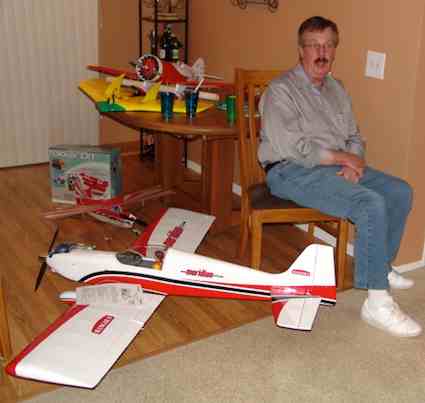 The first one he shared was his Hangar 9 Meridian 10cc ARF. He had the Evolution Engines 10GX gasoline powered engine installed. The engine uses a 20:1 gasoline to oil ratio mixture for fuel. The reason he brought it to an electric meeting is that Horizon Hobby provides all the information to do an electric conversion.
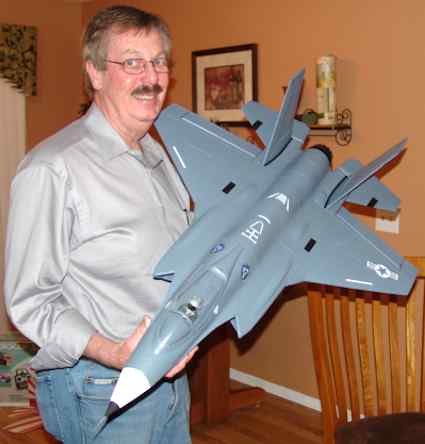 His second plane was a Hobby Lobby F-35 Lightning II 360 Degree Thrust Vectoring Jet. It is a receiver ready aircraft for only $199.99. It has a wingspan of 31.25 inches and flying weight of 36 oz. Joe noted that it takes off from grass very easily. 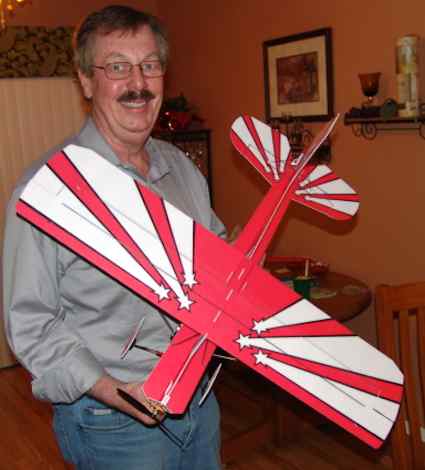 He also brought along a Great Planes ElectriFly Citabria. He noted that this 33" span, 6 oz. foam plane has carbon fiber reinforcements and pre-made pushrods. He fells that at $44.99 it is a good value. He said that he could even force it to so some 3D-type maneuvers. 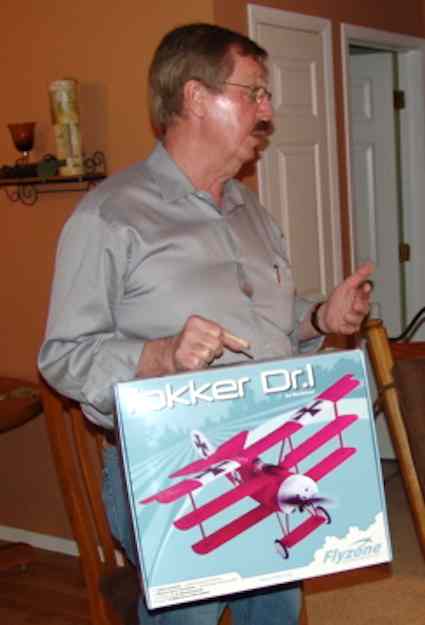 The fourth plane was a Flyzone Fokker Dr.1 WWI Micro EP Tx-R. It uses the Tactic radios or the Tactic Any-Link radio systems. 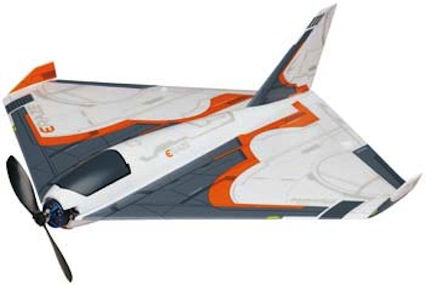 Joe also passed out an information sheet on the new Flyzone Eraze. He's had a chance to fly one and he likes it. 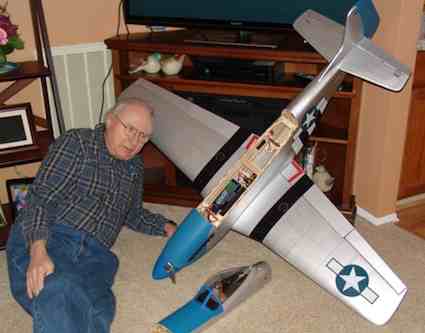 Tom Bacsanyi brought his Hangar 9 P-51D Blue Nose 60 ARF. He really liked several features of this ARF. It has a large access hatch in the top for accessing the batteries. The spinner is provided and nice done. It blends well into the cowl and has an aluminum backplate that recesses into the spinner. The optional retracts are operated by a standard retract servo that bolts onto the retract unit.
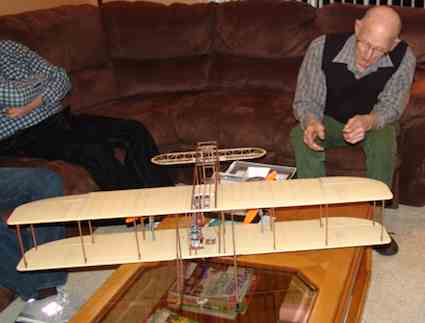 Bill Brown brought along his partially completed Wright Model B. An article in the Air & Space magazine got him going on this project.
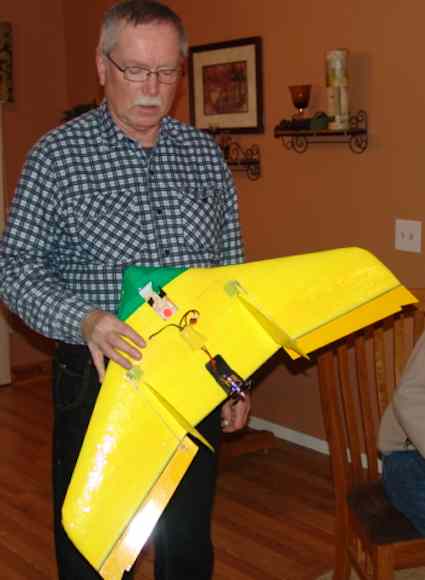 Richard Utkan, EFO vice-president, shared his Hobby People Wild Wing. It was a kit from several years ago that he has updated. It has a small outrunner with 2200Kv. The WOT watts in are 186 and it only weighs 17 oz. The covering is colored packing tape. He made the motor mount for the outrunner. He said that it flies very nicely at both high and low speed. 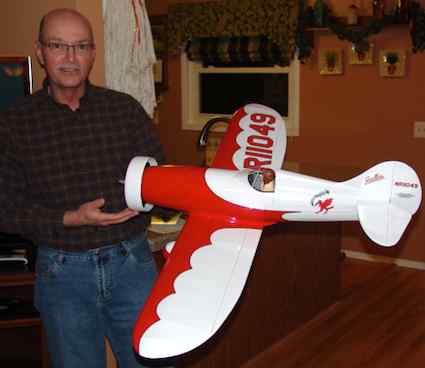 Denny Sumner brought his completed Gee Bee Y model. It was built from the short kit by Top Notch Products Company.
Jim Cross told us that Nankin Hobby of Farmington, MI has changed the name of its online store to Pro Star Hobby. Ken Myers showed parts of two videos from the Web that demonstrate how NOT to work on electrically powered models.
From Pete Foss via email I'd like to announce the date of the Skymasters Electric fly as June 15th with carryover on the 16th. Like last year, we have made arrangements with the DNR to allow overnight rustic camping at the field ($13) to facilitate NIGHT FLYING! Fliers can also stay and open fly on Sunday with the club. Hope to see lots of you there. Saturday, June 15, 2013 Skymasters' Field Event Flying Starts at 10 a.m. and goes until??? Potluck Dinner at the field, bonfire & NIGHT FLYING Camp overnight at the field. Open flying on Sunday. No Landing FEE!!! Lots of parking Refreshments available at the event Pilots' Prizes 94dBa 10 a.m. to 8 p.m. Night Fliers must be EXTRA quiet Field is located in the Bald Mountain Recreation Area About 5 Miles north of the Palace of Auburn Hills on Scripps Rd. between Lapeer Rd. (M24) and Joslyn Rd. Vehicles require Recreation Passport For more info email Pete Foss Pete Foss - Skymasters RC of Michigan EFO Member Howard Shorr Passes
Ken Myers received word that longtime EFO member Howard Shorr died on April 10th. Many of us were quite surprised to hear this at the April 11 meeting as we'd just seen and talked with him on Friday, April 5th at the Toledo RC Expo.
We will all miss him! Announcing the 29th Annual Mid-America Electric Flies Here are the links to the 2013 Flyer as well as the field map and local area hotels list. 2013 Map to the flying field and local hotels listing |
To Reach Ken Myers, you can land mail to the address at the top of the page. My E-mail address is: KMyersEFO@theampeer.org
